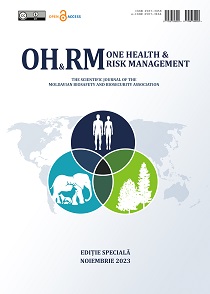Résumé
Introduction. Biological risks continue to intensify due to globalization and the ongoing emergence and re-emergence of communicable diseases. These factors are among the primary destabilizing elements of biological security and remain a major concern for the World Health Organization (WHO). Laboratories engaged in activities involving potential exposure to biological agents play a crucial role in establishing the etiological diagnosis, whether it be a suspicion or certainty, and serve as the frontline for detecting unusual infectious events.
Aim. Revealing the notions of biosafety and biosecurity in laboratories by performing a bibliographic analysis of the specialized literature.
Material and methods. For this study, a search was conducted in scientific databases, including PubMed, HINARI, and Cochrane. In the initial search using keywords, 23 articles were identified. Papers published between 2018 and 2022 were specifically chosen. After a thorough analysis of the selected papers, 6 were excluded as they did not sufficiently cover the topic. The final analysis included 17 articles.
Results. During the COVID-19 pandemic, biosafety and biosecurity measures have been recognized as crucial for mitigating the risks associated with handling and storing the SARS-CoV-2 virus. This crisis, accompanied by an increase in biological incidents at workplaces, underscores the need for laboratories to continuously enhance their risk management systems. Despite the implementation of increasingly effective isolation measures, rigorous laboratory practices, and continuous staff training, incidents and exposures still occur. This suggests that biosafety and biosecurity protocols are not always effectively or strictly followed. To address these risks, it is essential to identify, assess, and control them, aiming to prevent accidents, laboratory infections, and enhance overall safety and quality. Recent scientific evidence indicates that a standardized biosafety and biosecurity assessment and monitoring tool is a valuable and sustainable resource for biorisk management programs. Specifically, risk assessment tools enable precise measurement and comparison of biorisk management system performance. The results obtained through self-assessment and development tools facilitate the formulation of plans for improving biological risk management. This empowers each laboratory to adopt standardized operating procedures and evaluate its local risks.
Conclusions. According to WHO specialists, the use of an assessment tool is essential for enhancing biological risk management in laboratories. An intelligent biorisk assessment tool can be deployed to monitor the level of biosafety and biosecurity across all laboratories in the country. Recent threats, such as the Ebola virus, Zika, and SARS-CoV-2, have underscored the critical need for an effective biosafety and biosecurity system in laboratories. Such a system is paramount in ensuring the safety of laboratory personnel and limiting the spread of biological agents in the surrounding environment.
Note: This paper has been written within the framework of the project: 20.80009.8007.09 "Studying the mechanisms of antimicrobial resistance in gram-negative bacilli in order to strengthen the national surveillance system"
|
 Vues: 180|
|
Vues: 180|
|
Ce travail est disponible sous la licence Creative Commons Attribution 4.0 International .

